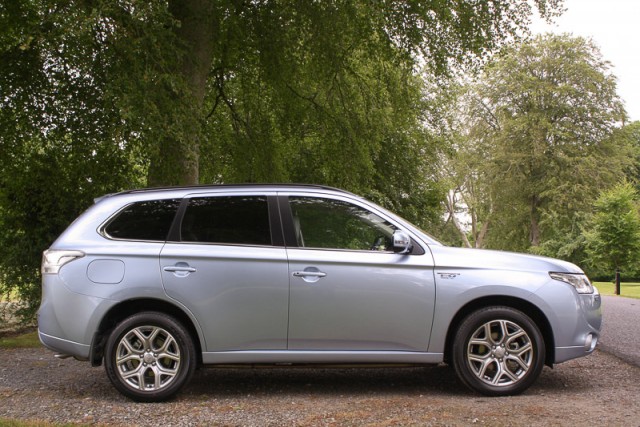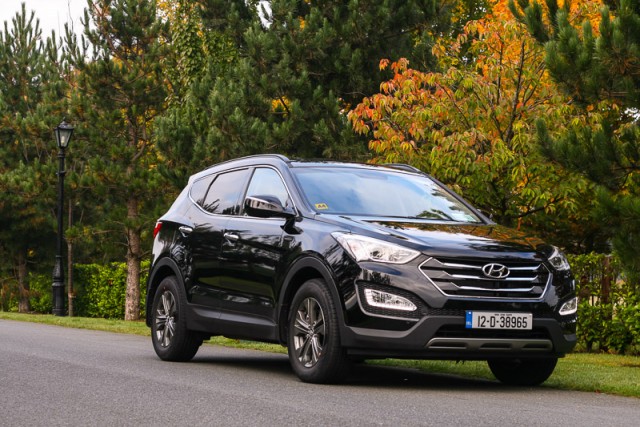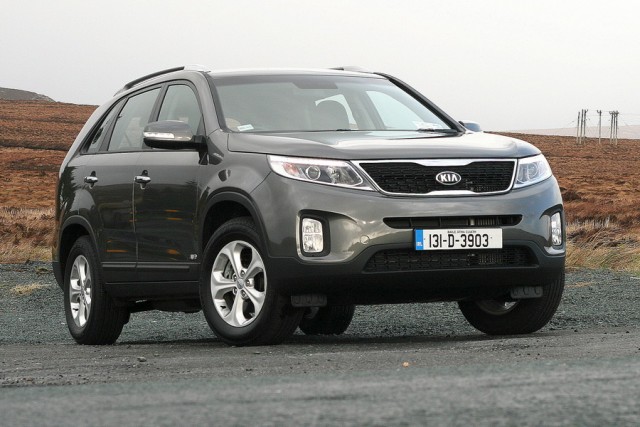Overall rating: 4/5
With the PHEV (Plug-in Hybrid Electric Vehicle) currently seen as the 'Goldilocks' formula for future drivetrain technology, Mitsubishi's clever packaging of it into the Outlander results in a mid-size SUV that should appeal to more than just the early adopters.

In the metal 3.5/5

Mitsubishi's new Outlander PHEV looks remarkably conventional and, more importantly, normal. Indeed, little differentiates it from its more traditionally-powered brethren. It's a smart more by Mitsubishi, as it is keen for this model to appeal not just to the tech-enthusiasts, but also to the mainstream. No doubt, the iMiEV still resonates in the Japanese firm's memory.
The eagle-eyed will notice that the PHEV version has been treated to a different front bumper design, along with model-specific alloy wheels. Towards the rear on the driver's side is an additional 'filler' flap, which, when opened, reveals both conventional and fast charge sockets - a smart move on Mitsubishi's part to include both. One other aesthetic feature that sets the PHEV version apart is the inclusion of clear rear light units, though we reckon these look like a cheap aftermarket add-on.

Inside, there is little to complain about. The raised SUV platform allows for ease of access and as the Outlander was always intended to carry the large batteries needed for a hybrid, the impact on cabin space is negligible. Rear seats lose out on 45mm of headroom as they are raised, while the two additional seats that made up a third row are eliminated. Boot space is also affected, but again only to a very small degree - capacity is 463 litres instead of the regular 477 litres, though the rear seats do fold down flat in a 60:40 split as before.

Much of the rest of the layout is as per the standard Outlander, and should you opt for the more expensive Intense+ trim level, the inclusion of leatherette upholstery, an electrically-adjusted driver's seat as well as a clear satellite navigation screen with reversing camera all help to make the €47,450 asking price a touch more palatable.

Driving it 4/5
As soon as you drive away in the Outlander PHEV it becomes clear that it is more electric vehicle than most current hybrids. Those who may have already experienced hybrids, like a Toyota Prius for example, are used to pulling away in silence and then having the engine kick in once up to higher speeds. Not so with the Mitsubishi. In fact, during our time driving it, we counted only a handful of times where the petrol engine actually came into play in order to propel the vehicle forward.
Yes, under situations involving full-load acceleration you will notice the engine, but for the majority of driving the Mitsubishi will either use only electric power. If the battery charge is low, or conditions require that bit more power, the petrol motor will come to life, but then remain at a steady (and therefore quieter) 1,700rpm. It essentially acts like a generator rather than an engine in the traditional sense.

Aside from the electrical wizardry going on underneath, the Outlander PHEV remains composed on the road, though despite the retuned suspension (to compensate for the additional weight now being carried) there is noticeable body roll in the corners, whilst at slow speeds over bumps and humps there is a distinct shimmy throughout the cabin, something that is more apparent due to the lack of driving noise.
Nonetheless, it offers an elevated view of the road ahead while lending itself to being quite manoeuvrable in tighter spaces; although, as mentioned earlier, only the higher specification benefits from a reversing camera. The steering is well weighted and despite the aforementioned body roll when cornering at speed the additional weight of the PHEV version goes largely unnoticed. Acceleration levels won't wow many, but this car isn't about performance, it's more a well-executed exercise in the maximisation of hybrid technology. Naturally the system can be left to its own devices, but the fact that users can decide how they want the system to work is an added bonus. Should you wish you use only electric power it will do so, while the option is also there to instruct the Outlander to not allow the battery reserve to drop below a certain level or range.

What you get for your money 4/5
Normally you can simply judge a car on how much it costs versus how much you get included in order to get a simple idea of value. With something like this Outlander PHEV one must also think of how much money can potentially be saved thanks to the reduced running costs both in terms of fuelling and also servicing. The entry-level PHEV model is priced at €2,000 more than the higher-level diesel model, which also costs €220 more to tax each year. The smart move would be to swallow the additional €5,500 to step up to the Intense+ trim level and enjoy the additional trappings while you consider the money you could end up saving in the long run.

Summary
In some ways Mitsubishi's rather nonchalant exterior design does the impressive technology underneath a disservice. Spending more time really living with the Outlander PHEV will show many just how practical and efficient a plug-in hybrid system can be, while the fact that its engine will not only provide added performance but also make range anxiety redundant should ease the transition to fully electric cars.











































